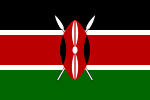
Back Masai Afrikaans شعب الماساي Arabic شعب الماساى ARZ Masái AST Masailər Azerbaijani ماسایلر AZB Маасайҙар Bashkir Масаі Byelorussian Масаі BE-X-OLD Масаи Bulgarian
 A gathering of Maasai men in 2005 | |
| Total population | |
|---|---|
| c. 2 million | |
| Regions with significant populations | |
| 1,189,522 (2019)[1] | |
| 800,000 [approximate] (2011)[2] | |
| Languages | |
| Maa (ɔl Maa), Swahili (Kiswahili) and English | |
| Religion | |
| Christianity, Maasai religion, Islam | |
| Related ethnic groups | |
| Samburu, Ilchamus people, Arsi Oromo and other Nilotic peoples | |
| Part of a series on the |
| Culture of Kenya |
|---|
 |
| Cuisine |
| Part of a series on the |
| Culture of Tanzania |
|---|
 |
| People |
| Languages |
| Religion |
| Literature |
| Music |
| Sport |
The Maasai (/ˈmɑːsaɪ, mɑːˈsaɪ/;[3][4] Swahili: Wamasai) are a Nilotic ethnic group inhabiting northern, central and southern Kenya and northern Tanzania, near the African Great Lakes region.[5] The Maasai speak the Maa language (ɔl Maa),[5] a member of the Nilotic language family that is related to the Dinka, Kalenjin and Nuer languages. Except for some elders living in rural areas, most Maasai people speak the official languages of Kenya and Tanzania, Swahili and English.[6]
The Maasai population has been reported as numbering 1,189,522 in Kenya in the 2019 census,[1] compared to 377,089 in the 1989 census, though many Maasai view the census as government meddling and therefore either refuse to participate or actively provide false information.[7][8][9]
- ^ a b "2019 Kenya Population and Housing Census Volume IV: Distribution of Population by Socio-Economic Characteristics". Kenya National Bureau of Statistics. Archived from the original on 5 June 2020. Retrieved 24 March 2020.
- ^ Ethnologue report for language code:mas Archived 2008-10-23 at the Wayback Machine ethnologue.com, '453,000 in Kenya (1994 I. Larsen BTL) ... 430,000 in Tanzania (1993)', Gordon, Raymond G., Jr. (ed.), 2005. Shai Amelie has Languages of the World, Fifteenth edition. Dallas, Tex.: SIL International
- ^ "Lexicon". Darkwing.uoregon.edu. Archived from the original on 30 June 2020. Retrieved 30 June 2020.
- ^ "Maasai". Collins English Dictionary. Archived from the original on 8 August 2022. Retrieved 9 December 2019.
- ^ a b Maasai - Introduction Archived 2008-07-04 at the Wayback Machine Jens Fincke, 2000–2003
- ^ Berntsen, John L. (Autumn 1976). "The Maasai and Their Neighbors: Variables of Interaction". African Economic History (2): 1–11. doi:10.2307/3601509. JSTOR 3601509. Archived from the original on 4 June 2021. Retrieved 20 September 2021.
- ^ "The Maasai People". Maasai Association. Archived from the original on 18 May 2020. Retrieved 27 June 2022.
- ^ "Kenya - Population Distribution". kenya.rcbowen.com. Archived from the original on 15 November 2012. Retrieved 25 August 2007.
- ^ Amin, Willetts & Eames 1987, p. 122.